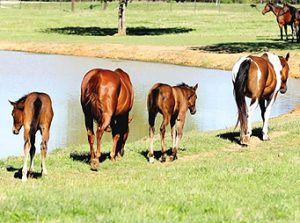Weaning Foals Using the Farmers’ Almanac
Click here to read the complete article180 – March/April 2019
BY KRISTEN SPINNING
 The Old Farmers’ Almanac has maintained an enduring and faithful readership since its inception in 1792. Early farmers took the Almanac’s advice very seriously for planning, predictions, planting, and animal health. While the world has changed much over the centuries, the Almanac’s Best Days advice continues to be one of its most popular features, right in league with its long range weather forecasts.
The Old Farmers’ Almanac has maintained an enduring and faithful readership since its inception in 1792. Early farmers took the Almanac’s advice very seriously for planning, predictions, planting, and animal health. While the world has changed much over the centuries, the Almanac’s Best Days advice continues to be one of its most popular features, right in league with its long range weather forecasts.
There is a short astrology section in every edition of the Almanac, along with the Secrets of the Zodiac and the Man of Signs graphics. Almanac devotees use its astronomical data and astrological tables to determine the timing of a variety of events. Astrology interprets the influence that the sun and moon exert on people, animals, and even weather, while the planets are in a specific zodiac sign. The phases of the moon and its visual proximity to a constellation or a planet were, and still are, used to determine the most fortuitous times for a variety of activities. The practice is referred to as using “the Signs,” and some horse breeders still use them to determine the best days for weaning foals.
The Almanac’s astronomer, Celeste Longacre, shares her insight on the subtleties of using the Signs for weaning. She notes that the Signs have been associated with different parts of the body for centuries, saying, “You would find the same associations during Hippocrates’s time.” The first sign of the zodiac, Aries, was attributed to the head, with the rest of the signs moving down the body, and ending with Pisces at the feet. “Unlike other activities, I use the Moon’s association with Pluto to determine the best time for weaning. Pluto has to do with all things that change. When the Moon is in a favorable aspect to the planet, I feel that change is much easier. So, the actual zodiac sign that the Moon is in for weaning changes over time, as all of the planets are constantly moving.”
Most horsemen will say that there is no hard and fast time to wean a foal since age isn’t as important as physical, mental, and social development. Some opt for the three month mark, while others leave a mare and foal together until the baby is four, five, or even six months old. Regardless of the age of the foal, most everyone agrees that reducing stress for both mom and baby is vital for both to thrive. The theory of the Signs is that the physical and emotional stress of weaning will be at its lowest on certain days of the lunar cycle. Decades of anecdotal evidence and success keep this very old tradition alive and relevant in an age of scientific advances like embryo transfers and infrared thermography.
Click here to read the complete article180 – March/April 2019










